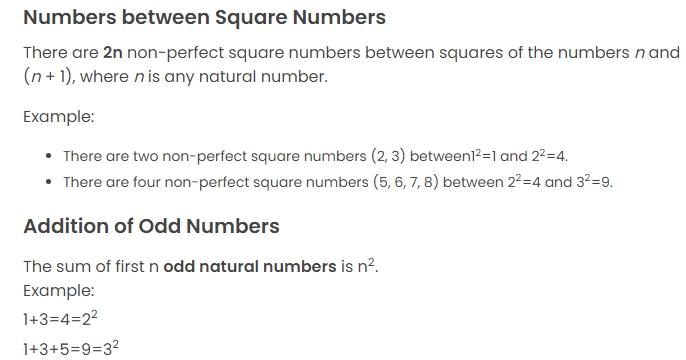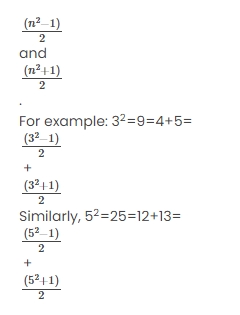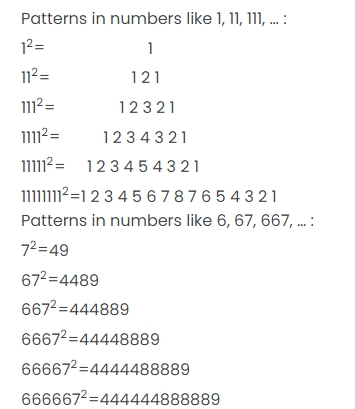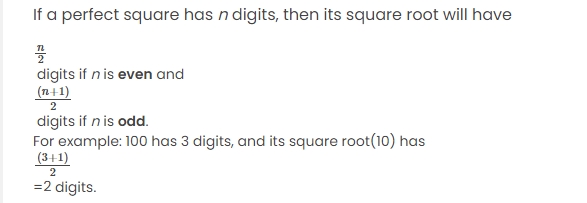

CBSE Class 8 Maths Notes Chapter 5: Chapter 5 of CBSE Class 8 Maths, "Squares and Square Roots," explores squaring a number and finding its square root.
The chapter begins with defining squares, showing how multiplying a number by itself results in its square. It then explains the properties of perfect squares and teaches methods to find square roots, including prime factorization and long division.CBSE Class 8 Maths Notes Chapter 5 Overview
Chapter 5 of CBSE Class 8 Maths, "Squares and Square Roots," delves into the fundamental concepts of squares and square roots. The chapter begins by explaining the square of a number, which results from multiplying the number by itself. It covers the properties of perfect squares, emphasizing how they always end in specific digits, such as 0, 1, 4, 5, 6, or 9. The chapter also introduces square roots, the inverse operation of squaring. Students learn to find square roots using the prime factorization method and the long division method. The concept of estimating square roots for non-perfect squares is also covered, helping students' approximate roots when exact values aren't easily obtainable.CBSE Class 8 Maths Notes Chapter 5 PDF Download
This chapter builds a strong foundation for understanding higher-level concepts in algebra and geometry, making it crucial for students aiming to excel in mathematics. Here we have provided CBSE Class 8 Maths Notes Chapter 5 Squares and Square Roots pdf -CBSE Class 8 Maths Notes Chapter 5 PDF
CBSE Class 8 Maths Notes Chapter 5
Below we have provided CBSE Class 8 Maths Notes Chapter 5 Squares and Square Roots -Introduction to Square Numbers
If a natural number m can be expressed as n 2 , where n is also a natural number, then m is a square number. Example: 1, 4, 9, 16 and 25.
Finding the Square of a Number
If n is a number, then its square is given as n × n = n 2 . For example: Square of 5 is equal to 5 × 5 = 25Properties of Square Numbers
Square numbers have the following characteristics:- A number may or may not be square if it has 0, 1, 4, 5, 6, or 9 in the unit's location. A number is not square if it has 2, 3, 7, or 8 in its unit of measurement.
- A number's square terminates in 1 if its unit is either 1 or 9. The number whose square it is will have either 4 or 6 in unit whenever a square number ends in 6.
- For illustration, think about the number 64. Four, a square number, is the unit digit for the number 64. since 64 is the square of 8 and 64 is regarded as a square number.
- Think of the number 11 (that is, the unit of 11 is 1). 11 squared is therefore 121. As a result, square number 121 also has 1 instead of the unit.
Finding square of a number with unit’s place 5
The square of a number N5 is equal to (N(N+1))×100+25, where N can have one or more than one digits. For example: If N = 1, then 15 2 =(1×2)×100+25=200+25=225 If N = 20, then 205 2 =(20×21)×100+25=42000+25=42025Perfect Squares
A number which is obtained from square of the other number is called perfect squares. For example, 81 is a perfect square number, which is obtained by taking the square of the number 9.Interesting Patterns
There exists interesting patterns in:- Adding triangular numbers
- Numbers between square numbers
- Adding odd numbers
- A sum of consecutive natural numbers
- Product of two consecutive even or odd natural numbers
Adding Triangular Numbers
Triangle numbers are made up of the digits 1, 3, 6, 10, 15, and so on. The natural numbers are continued to be added up to obtain it. Triangles can be formed from a triangular number's dot pattern. If we add two consecutive triangular numbers, we get a square number.
If we add two consecutive triangular numbers, we get a square number.

Square of an odd number as a sum
Square of an odd number n can be expressed as sum of two consecutive positive integers
Product of Two Consecutive Even or Odd Natural Numbers

Random Interesting Patterns Followed by Square Numbers

Pythagorean Triplets

Square Roots
Square Root of a Number
Finding the number whose square is known is known as finding the square root . Finding square root is inverse operation of finding the square of a number. For example:
Estimating the number of digits in the square root of a number

Estimating Square Roots

Finding square of a number using identity

Square Roots of Perfect Squares
Finding square root through repeated subtraction
Any square number can be written as the sum of all subsequent odd natural numbers, beginning with one. Subtraction can be done repeatedly to find the square root. In order to determine a number n's square root: First, deduct one from each subsequent odd number. Step 2: When you reach zero, stop. The square root of an integer is determined by subtracting the number of consecutive odd numbers from that number. Let's say we wish to calculate 36's square root.- 36 − 1 = 35
- 35 − 3 = 32
- 32 − 5 = 27
- 27 − 7 = 20
- 20 − 9 = 11
- 11 − 11 = 0
Finding Square Root by Long Division Method
The steps to using the long division method to obtain the square root of 484 are as follows:- Step 1: Beginning with the digit at the units location, place a bar over each pair of numbers. There will also be a bar on the leftmost single digit if the number of digits in it is unusual.
- Step 2: The greatest integer whose square is less than or equal to the number on the far left should be used as the divisor. Split and write the remainder.
- Step 3: Bring down the number which is under the next bar to the right side of the remainder.
- Step 4: Double the value of the quotient and enter it with a blank on the right side.
- Step 5: Determine the largest digit that may be used to fill the blank. This number will also become the new digit in the quotient, and it must be such that the product of the new quotient and the new divisor is less than or equal to the dividend.
Benefits of CBSE Class 8 Maths Notes Chapter 5
Here are the benefits of studying CBSE Class 8 Maths Notes for Chapter 5, "Squares and Square Roots":Conceptual Clarity : The notes provide a clear understanding of fundamental concepts like squares and square roots, helping students grasp these mathematical ideas easily.
Problem-Solving Skills : By practicing the methods of finding square roots, such as prime factorization and long division, students improve their problem-solving abilities, which are essential for tackling more complex math problems in higher classes.
Quick Revision : The notes offer a concise summary of the chapter, making it easier for students to quickly revise key concepts before exams or tests.
Confidence Building : Understanding and mastering the concepts in this chapter boosts students' confidence in their math skills, preparing them for more advanced topics.
Application in Real Life : The chapter links mathematical concepts to real-life applications, such as using square roots in measurements and geometry, making learning more relevant and interesting.
Foundation for Higher Studies : The knowledge gained from this chapter serves as a strong foundation for algebra, geometry, and trigonometry in higher classes.
CBSE Class 8 Maths Notes Chapter 5 FAQs
What are the rules of square and square root?
What is the importance of squares and square roots?
What is not allowed in square root?
What is a common mistake for square roots?











